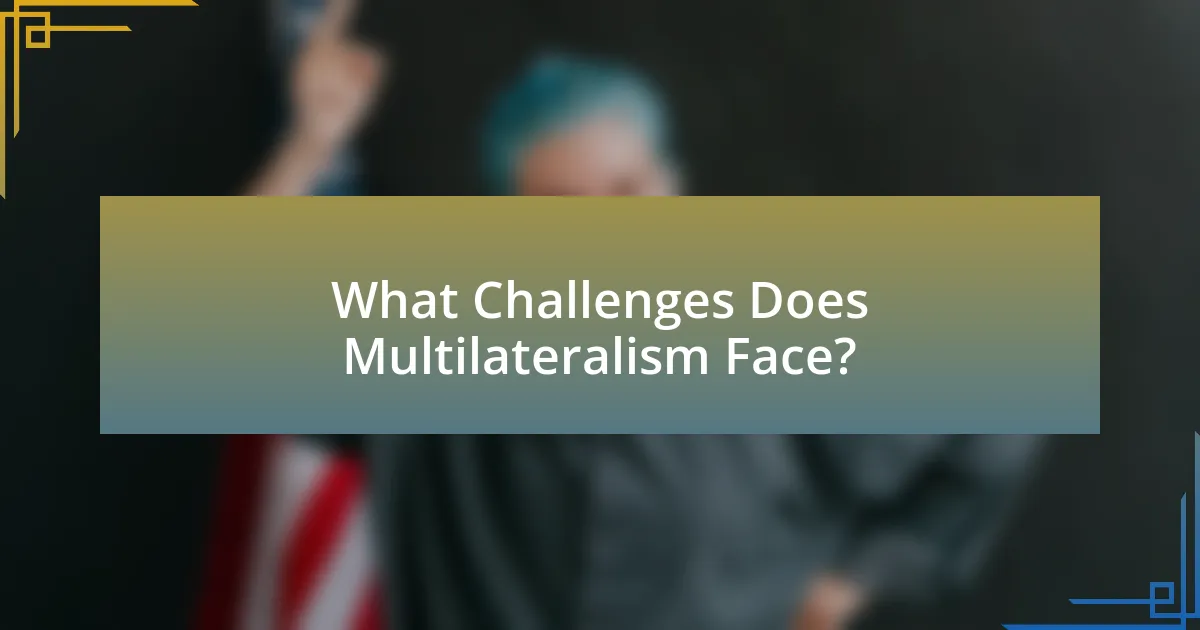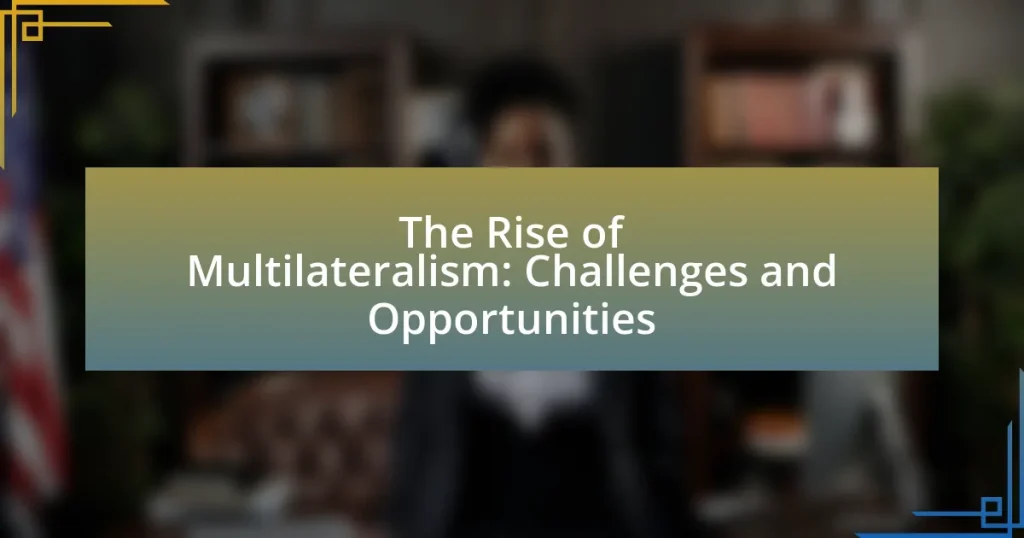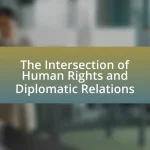Multilateralism is a diplomatic approach where multiple countries collaborate to address global challenges through collective decision-making, exemplified by frameworks like the United Nations and the Paris Agreement on climate change. The article explores the rise of multilateralism, driven by globalization, interdependence, and the need for coordinated responses to issues such as climate change and pandemics. It also examines the historical context, contrasting multilateralism with unilateralism and bilateralism, and highlights the challenges it faces, including nationalism and geopolitical tensions. Additionally, the article discusses the role of international organizations, the economic benefits of multilateral agreements, and strategies to strengthen multilateralism for effective global cooperation.

What is Multilateralism and Why is it Rising?
Multilateralism is a diplomatic approach where multiple countries work together on common issues, often through international organizations like the United Nations or the World Trade Organization. Its rise can be attributed to increasing global interdependence, where challenges such as climate change, pandemics, and economic instability require collaborative solutions. For instance, the Paris Agreement on climate change exemplifies how nations unite to address a shared threat, highlighting the necessity of multilateral cooperation in an interconnected world.
How is multilateralism defined in the current global context?
Multilateralism in the current global context is defined as the cooperative engagement of multiple countries in addressing shared challenges through collective decision-making and action. This approach is increasingly relevant as global issues such as climate change, pandemics, and international security require coordinated responses that no single nation can effectively manage alone. For instance, the Paris Agreement on climate change exemplifies multilateralism, where nearly 200 countries committed to reducing greenhouse gas emissions to combat global warming. This framework illustrates how multilateralism facilitates collaboration and establishes norms that guide international relations, reflecting a shift from unilateral or bilateral approaches to more inclusive global governance.
What historical events have contributed to the rise of multilateralism?
The rise of multilateralism has been significantly influenced by key historical events such as the aftermath of World War II, the establishment of the United Nations in 1945, and the Cold War dynamics. The devastation of World War II prompted nations to seek cooperative frameworks to prevent future conflicts, leading to the creation of the United Nations, which aimed to foster international dialogue and collaboration. Additionally, the Cold War era saw the formation of various multilateral alliances and treaties, such as NATO in 1949 and the Warsaw Pact in 1955, which were designed to address security concerns through collective action. These events collectively underscored the importance of multilateralism in addressing global challenges and maintaining peace.
How does multilateralism differ from unilateralism and bilateralism?
Multilateralism involves multiple countries working together to address global issues, while unilateralism refers to a single country acting independently, and bilateralism involves two countries collaborating. In multilateralism, decisions are made collectively, often through international organizations like the United Nations, which facilitates cooperation on issues such as climate change and trade. Unilateralism can lead to isolation and conflict, as seen when the United States withdrew from the Paris Agreement in 2017, prioritizing national interests over global consensus. Bilateralism, exemplified by trade agreements between two nations, can be effective but may not address broader global challenges that require wider cooperation. Thus, multilateralism is characterized by inclusivity and collective action, contrasting with the more limited approaches of unilateralism and bilateralism.
What are the key drivers behind the rise of multilateralism?
The key drivers behind the rise of multilateralism include globalization, the need for collective action on global issues, and the increasing interdependence of nations. Globalization has facilitated economic ties and cultural exchanges, prompting countries to collaborate on trade and investment agreements. The urgency of addressing transnational challenges such as climate change, terrorism, and pandemics has underscored the necessity for coordinated responses, leading to the establishment of international frameworks and organizations. Additionally, the interdependence of nations in areas like technology and security has made multilateral cooperation essential for addressing shared concerns effectively. These factors collectively reinforce the trend toward multilateralism in international relations.
How do global challenges like climate change influence multilateralism?
Global challenges like climate change significantly influence multilateralism by necessitating cooperative international efforts to address shared threats. Climate change impacts, such as rising sea levels and extreme weather events, compel nations to collaborate through frameworks like the Paris Agreement, which aims to limit global warming. This collaboration is evidenced by the commitment of 196 parties to reduce greenhouse gas emissions and enhance climate resilience, highlighting the need for collective action. As countries recognize that unilateral approaches are insufficient to tackle such a pervasive issue, multilateralism becomes essential for effective policy-making and resource allocation in the face of climate-related challenges.
What role do international organizations play in promoting multilateralism?
International organizations play a crucial role in promoting multilateralism by facilitating cooperation among states to address global challenges. They provide platforms for dialogue, negotiation, and consensus-building, which are essential for collective action on issues such as climate change, trade, and security. For instance, the United Nations, through its various agencies, enables member states to collaborate on international treaties and agreements, exemplified by the Paris Agreement on climate change, which was adopted by 196 parties in 2015. This demonstrates how international organizations not only foster multilateral engagement but also help establish binding commitments that reflect the collective will of the global community.
What opportunities does the rise of multilateralism present?
The rise of multilateralism presents opportunities for enhanced global cooperation and collective problem-solving. This collaborative approach allows nations to address transnational issues such as climate change, trade disputes, and public health crises more effectively. For instance, the Paris Agreement exemplifies how multilateral efforts can unite countries to combat climate change, demonstrating that shared goals can lead to significant environmental commitments. Additionally, multilateralism fosters economic partnerships, as seen in trade agreements like the Comprehensive and Progressive Agreement for Trans-Pacific Partnership, which can stimulate economic growth and reduce trade barriers among member countries.
How can multilateralism enhance global cooperation?
Multilateralism enhances global cooperation by facilitating dialogue and collaboration among multiple countries to address shared challenges. This approach allows nations to pool resources, share knowledge, and create collective solutions to issues such as climate change, trade disputes, and security threats. For instance, the Paris Agreement, which involves nearly 200 countries, exemplifies how multilateral efforts can lead to coordinated action on climate change, demonstrating that collective commitments can yield significant environmental benefits. Additionally, multilateral organizations like the United Nations provide platforms for negotiation and conflict resolution, further strengthening international partnerships and fostering a sense of global community.
What economic benefits arise from multilateral agreements?
Multilateral agreements provide significant economic benefits, including enhanced trade, increased market access, and improved economic stability. These agreements facilitate the reduction of tariffs and trade barriers among member countries, leading to a rise in trade volumes. For instance, the World Trade Organization (WTO) estimates that trade liberalization through multilateral agreements can increase global GDP by up to 1.5%. Additionally, multilateral agreements often promote foreign direct investment (FDI) by creating a more predictable and stable business environment, which encourages companies to invest across borders. The North American Free Trade Agreement (NAFTA), for example, resulted in a substantial increase in trade and investment among the U.S., Canada, and Mexico, demonstrating the positive economic impact of such agreements.

What Challenges Does Multilateralism Face?
Multilateralism faces significant challenges, including rising nationalism, geopolitical tensions, and the erosion of trust among states. Nationalism has surged in various countries, leading to a preference for bilateral agreements over multilateral cooperation, as seen in the United States’ withdrawal from the Trans-Pacific Partnership in 2017. Geopolitical tensions, particularly between major powers like the U.S. and China, complicate consensus-building in international forums, evidenced by stalled negotiations in the World Trade Organization. Additionally, the erosion of trust is highlighted by the increasing skepticism towards international institutions, as demonstrated by the criticism of the United Nations’ effectiveness in addressing global crises. These factors collectively hinder the effectiveness and sustainability of multilateralism in addressing global challenges.
What are the main obstacles to effective multilateral cooperation?
The main obstacles to effective multilateral cooperation include differing national interests, lack of trust among states, and inadequate institutional frameworks. Differing national interests often lead to conflicting priorities, making consensus difficult; for example, countries may prioritize economic growth over environmental concerns, hindering collaborative efforts on climate change. Lack of trust among states can result from historical grievances or perceived power imbalances, which can stymie negotiations and cooperation, as seen in the tensions between developed and developing nations during trade discussions. Inadequate institutional frameworks, such as weak enforcement mechanisms in international agreements, can further complicate cooperation, as evidenced by the challenges faced by the United Nations in implementing resolutions effectively.
How do national interests conflict with multilateral goals?
National interests often conflict with multilateral goals because countries prioritize their own economic, political, and security objectives over collective agreements. For instance, during climate negotiations, nations may resist binding commitments to reduce emissions if it threatens their economic growth or energy security, as seen in the reluctance of major fossil fuel producers to adopt stringent climate policies. This tension illustrates how individual states may prioritize short-term gains or national sovereignty, undermining the effectiveness of multilateral efforts aimed at addressing global challenges.
What impact does populism have on multilateralism?
Populism negatively impacts multilateralism by fostering nationalism and undermining international cooperation. Populist leaders often prioritize domestic interests over global collaboration, leading to a decline in support for multilateral agreements and institutions. For instance, the rise of populist movements in countries like the United States and Brazil has resulted in withdrawal from international accords, such as the Paris Agreement on climate change and the World Health Organization’s initiatives. This trend illustrates how populism can erode the foundations of multilateralism, as it promotes a zero-sum perspective that diminishes collective action on global challenges.
How do power dynamics affect multilateralism?
Power dynamics significantly influence multilateralism by determining which states can shape international norms and policies. Dominant powers often set the agenda in multilateral forums, leading to outcomes that reflect their interests, as seen in the United Nations Security Council, where permanent members wield veto power. This concentration of influence can marginalize smaller states and limit their participation in decision-making processes, thereby affecting the overall effectiveness and legitimacy of multilateral agreements. For instance, the Paris Agreement on climate change illustrates how major economies like the United States and China can drive negotiations, impacting global climate policy and commitments from other nations.
What role do emerging economies play in shaping multilateral frameworks?
Emerging economies play a crucial role in shaping multilateral frameworks by influencing global governance and policy-making processes. These economies, such as Brazil, India, and China, contribute to multilateral discussions by representing the interests of developing nations, thereby promoting a more inclusive approach to international cooperation. For instance, the BRICS group, which includes Brazil, Russia, India, China, and South Africa, has actively participated in reforming institutions like the International Monetary Fund (IMF) to better reflect the economic realities of the 21st century. This shift is evidenced by the 2010 IMF quota reforms, which aimed to increase the voting power of emerging economies, highlighting their growing significance in global economic governance.
How does the influence of major powers challenge multilateralism?
The influence of major powers challenges multilateralism by prioritizing national interests over collective decision-making. Major powers, such as the United States and China, often leverage their economic and military strength to shape international norms and agreements in ways that favor their own agendas, undermining the principles of equality and cooperation that multilateralism is built upon. For instance, the U.S. withdrawal from the Paris Agreement in 2017 exemplified how a single nation’s actions can disrupt global climate initiatives, illustrating the fragility of multilateral commitments when major powers act unilaterally. This dynamic creates an environment where smaller nations may feel pressured to align with dominant powers, further eroding the effectiveness and legitimacy of multilateral institutions.
What are the implications of failing to address these challenges?
Failing to address the challenges of multilateralism can lead to increased geopolitical tensions and a decline in global cooperation. Without effective collaboration, nations may resort to unilateral actions, undermining international agreements and fostering conflict. Historical examples, such as the rise of nationalism in the 1930s, demonstrate that neglecting multilateral frameworks can result in economic instability and war. Additionally, the inability to tackle global issues like climate change and pandemics can exacerbate crises, leading to widespread humanitarian consequences and economic downturns.
How could a decline in multilateralism affect global stability?
A decline in multilateralism could significantly destabilize global stability by increasing tensions between nations and undermining cooperative frameworks. Historical evidence shows that periods of reduced multilateral engagement, such as the interwar years, often lead to isolationism, conflict, and economic instability. For instance, the rise of nationalism and protectionism in the 1930s contributed to the outbreak of World War II, illustrating how diminished international cooperation can escalate geopolitical rivalries. Furthermore, without multilateral institutions to mediate disputes and foster dialogue, countries may resort to unilateral actions, increasing the likelihood of conflicts and crises.
What risks arise from a fragmented international system?
A fragmented international system increases the risks of conflict, instability, and ineffective global governance. This fragmentation can lead to competing national interests that undermine collective action on pressing issues such as climate change, terrorism, and pandemics. For instance, the lack of a unified response during the COVID-19 pandemic highlighted how fragmented approaches can exacerbate health crises and economic downturns. Additionally, historical examples, such as the rise of nationalism in the early 20th century, demonstrate that fragmentation can lead to geopolitical tensions and wars, as nations prioritize their interests over collaborative solutions.

How Can Multilateralism Be Strengthened?
Multilateralism can be strengthened by enhancing cooperation among nations through inclusive dialogue and shared decision-making processes. This approach fosters trust and collaboration, as evidenced by the success of international agreements like the Paris Agreement, which brought together 196 countries to address climate change collectively. Additionally, increasing the representation of diverse voices in multilateral institutions can ensure that the interests of smaller or developing nations are considered, thereby promoting equity and sustainability in global governance.
What strategies can enhance the effectiveness of multilateral institutions?
Enhancing the effectiveness of multilateral institutions can be achieved through strategies such as improving decision-making processes, increasing transparency, and fostering inclusive participation. Streamlined decision-making can reduce bureaucratic delays, allowing for quicker responses to global challenges, as seen in the World Health Organization’s rapid mobilization during health crises. Increasing transparency builds trust among member states, which is crucial for cooperation; for instance, the United Nations has implemented measures to enhance accountability in its operations. Lastly, fostering inclusive participation ensures that diverse perspectives are considered, leading to more comprehensive solutions, as demonstrated by the Paris Agreement, which involved extensive stakeholder engagement.
How can member states improve collaboration within multilateral frameworks?
Member states can improve collaboration within multilateral frameworks by enhancing communication and establishing clear, shared objectives. Effective communication fosters trust and understanding among member states, which is essential for coordinated action. For instance, the United Nations has seen increased cooperation among its member states when they engage in regular dialogues and consultations, leading to more unified responses to global challenges such as climate change and health crises. Additionally, setting specific, measurable goals allows member states to align their efforts and track progress, as demonstrated by the Sustainable Development Goals (SDGs), which have mobilized countries to work together towards common targets.
What reforms are necessary for international organizations to adapt to current challenges?
International organizations must implement reforms focused on enhancing governance, increasing transparency, and fostering inclusivity to effectively adapt to current challenges. Enhanced governance structures can streamline decision-making processes, allowing organizations to respond more swiftly to global crises, as evidenced by the slow response of the World Health Organization during the COVID-19 pandemic. Increasing transparency in operations and funding can build trust among member states and stakeholders, which is crucial for collaborative efforts. Furthermore, fostering inclusivity by integrating diverse voices, particularly from underrepresented nations, can lead to more equitable and effective solutions, as highlighted by the need for broader representation in climate negotiations. These reforms are essential for international organizations to remain relevant and effective in addressing complex global issues.
What role does civil society play in supporting multilateralism?
Civil society plays a crucial role in supporting multilateralism by advocating for inclusive policies and holding governments accountable. Organizations within civil society, such as non-governmental organizations (NGOs) and grassroots movements, mobilize public opinion and provide expertise on global issues, thereby influencing international negotiations. For instance, during the Paris Agreement discussions in 2015, civil society groups significantly contributed to raising awareness about climate change and pushing for stronger commitments from states. Their involvement ensures that diverse voices are heard, promoting transparency and fostering collaboration among nations.
How can public engagement foster a culture of multilateral cooperation?
Public engagement can foster a culture of multilateral cooperation by enhancing communication and collaboration among diverse stakeholders. When citizens actively participate in discussions about global issues, they contribute to a shared understanding of challenges and potential solutions, which is essential for effective multilateralism. For instance, initiatives like the United Nations’ Global Goals encourage public involvement, leading to increased awareness and support for international cooperation. Research shows that countries with higher levels of public engagement in foreign policy tend to have more robust multilateral relationships, as citizens advocate for collaborative approaches to global problems.
What initiatives can bridge the gap between governments and citizens?
Initiatives that can bridge the gap between governments and citizens include participatory budgeting, community engagement programs, and digital platforms for civic participation. Participatory budgeting allows citizens to directly influence how public funds are allocated, fostering transparency and accountability. Community engagement programs, such as town hall meetings and public forums, encourage dialogue between government officials and citizens, ensuring that diverse voices are heard in decision-making processes. Digital platforms, like e-petitions and online surveys, facilitate real-time feedback and enable citizens to express their opinions on policies, enhancing governmental responsiveness. These initiatives have been shown to improve trust in government and increase civic involvement, as evidenced by studies indicating that participatory budgeting can lead to higher satisfaction with public services and greater civic engagement.
What practical steps can countries take to promote multilateralism?
Countries can promote multilateralism by actively participating in international organizations and fostering collaborative agreements. By engaging in platforms such as the United Nations, World Trade Organization, and regional alliances, nations can address global challenges collectively. For instance, the Paris Agreement on climate change exemplifies how countries can unite to tackle environmental issues through shared commitments. Additionally, countries can enhance multilateralism by prioritizing diplomatic dialogue, which facilitates understanding and cooperation on various issues, as seen in the successful negotiations of the Iran nuclear deal. Implementing policies that support trade liberalization and reducing barriers can also strengthen multilateral ties, evidenced by the positive outcomes of trade agreements like NAFTA.
How can nations balance national interests with global responsibilities?
Nations can balance national interests with global responsibilities by engaging in multilateral diplomacy that prioritizes both domestic priorities and international cooperation. This approach allows countries to negotiate agreements that address global challenges, such as climate change and public health, while also protecting their own economic and security interests. For instance, the Paris Agreement on climate change exemplifies how nations can commit to reducing emissions while considering their unique economic contexts. By participating in international organizations and treaties, nations can align their policies with global standards, fostering collaboration that ultimately benefits both national and global objectives.
What best practices can be adopted to ensure successful multilateral negotiations?
Successful multilateral negotiations can be ensured by adopting best practices such as establishing clear objectives, fostering open communication, and building trust among participants. Clear objectives provide a roadmap for discussions, ensuring that all parties understand the desired outcomes. Open communication encourages transparency and allows for the exchange of ideas, which is crucial in addressing diverse perspectives. Building trust among participants is essential, as it facilitates collaboration and reduces the likelihood of conflicts. Historical examples, such as the Paris Agreement negotiations in 2015, demonstrate that these practices lead to more effective and inclusive outcomes, as they enable countries to work together towards common goals while respecting individual interests.















